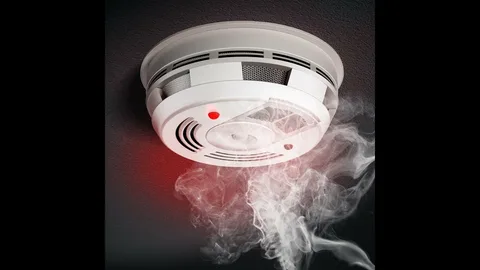In a world filled with uncertainties, one thing we can all agree on is the importance of safety. Whether it’s protecting our homes, businesses, or loved ones, having reliable smoke detection technology is crucial in preventing disasters. But did you know that there are not one, but two types of smoke detection technologies? Join me as we start on a journey to unravel the mysteries of these two guardians of safety!

Table of Contents
The Duo of Smoke Detection Technologies: A Dynamic Duo
Smoke detection technologies – the unsung heroes of fire prevention. But wait, there’s not just one, but two types of these trusty guardians! Meet the dynamic duo: ionization smoke detectors and photoelectric smoke detectors. Together, they form an unstoppable team dedicated to keeping us safe from the dangers of smoke and fire. 🦸♂️🔥
Ionization Smoke Detectors: The Early Bird Catches the Smoke
First up, we have ionization smoke detectors – the early bird of smoke detection. These clever contraptions work by using a small amount of radioactive material to ionize the air inside the detector. When smoke particles enter the chamber, they disrupt the ionization process, triggering the alarm. It’s like having a smoke-sensitive superhero guarding your home 24/7! 💨🚨
But wait, there’s a catch – ionization smoke detectors are notorious for their sensitivity to cooking fumes and steam. So unless you want your smoke detector going off every time you whip up a batch of popcorn, it’s best to install these bad boys away from the kitchen and bathroom. After all, nobody likes a false alarm – especially not at 3 am!
Photoelectric Smoke Detectors: The Watchful Guardian
Next up, we have photoelectric smoke detectors – the watchful guardian of smoke detection. Unlike their ionization counterparts, photoelectric smoke detectors rely on beams of light to detect smoke particles. When smoke enters the chamber, it scatters the light beams, triggering the alarm. It’s like having a smoke-sensitive security guard keeping a vigilant eye on your home at all times! 🕵️♂️💡
But here’s the kicker – photoelectric smoke detectors are less sensitive to cooking fumes and steam than ionization detectors. This makes them a popular choice for kitchens and bathrooms, where false alarms are more likely to occur. Plus, with their advanced technology and reliable performance, you can rest easy knowing that your home is in good hands.
Conclusion:
In the realm of fire safety, having reliable smoke detection technology is paramount. While there are many options to choose from, the two main types of smoke detectors – ionization and photoelectric – each bring their own unique strengths to the table.
Ionization smoke detectors are like the early birds of smoke detection, sensitive to fast-burning fires but prone to false alarms from cooking fumes. On the other hand, photoelectric smoke detectors are the watchful guardians, less sensitive to cooking fumes, and better at detecting slow, smoldering fires.
But why choose between the two when you can have the best of both worlds? Many experts recommend using a combination of ionization and photoelectric smoke detectors or investing in dual-sensor detectors that combine both technologies. This ensures comprehensive coverage and maximum protection against the dangers of smoke and fire.
So whether you’re outfitting your home, office, or industrial facility, remember to prioritize safety by investing in quality smoke detection technology. After all, when it comes to fire safety, it’s better to be safe than sorry! 🔥🚨
Frequently Asked Questions
Which type of smoke detector is better: ionization or photoelectric?
Both ionization and photoelectric smoke detectors have their strengths and weaknesses. Ionization detectors are more sensitive to fast-burning, flaming fires, while photoelectric detectors are better at detecting slow, smoldering fires. For optimal safety, experts recommend using a combination of both types of detectors or installing dual-sensor detectors that combine both technologies.
How often should smoke detectors be tested and replaced?
Smoke detectors should be tested at least monthly to ensure they function properly. Additionally, the batteries should be replaced annually, and the detectors themselves should be replaced every 8-10 years, or as the manufacturer recommends. Regular maintenance is key to ensuring that your smoke detectors remain effective in detecting smoke and alerting you to potential fires.
Can smoke detectors be interconnected?
Yes, many smoke detectors can be interconnected so that when one detector detects smoke, all interconnected detectors sound their alarms simultaneously. This ensures that occupants are alerted to the presence of smoke no matter where they are in the building, providing valuable time to evacuate safely. Interconnected smoke detectors are commonly used in larger homes and commercial buildings to enhance safety.
Can smoke detectors detect carbon monoxide (CO) gas as well?
While traditional smoke detectors are designed specifically to detect smoke particles, there is a combination of smoke and carbon monoxide detectors available on the market. These devices offer dual protection by alerting occupants to the presence of both smoke and CO gas, providing comprehensive safety coverage for your home or business.
Are there any alternative smoke detection technologies available?
In addition to ionization and photoelectric smoke detectors, there are other emerging smoke detection technologies, such as aspirating smoke detection (ASD) and air sampling smoke detection (ASSD). These advanced systems use air sampling technology to detect smoke particles at an early stage, making them ideal for high-risk environments such as data centers, museums, and archives.
